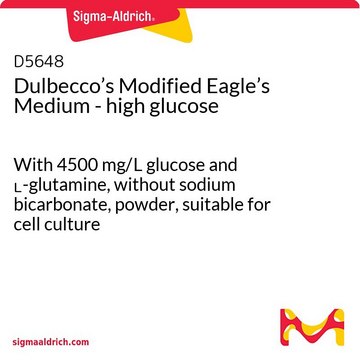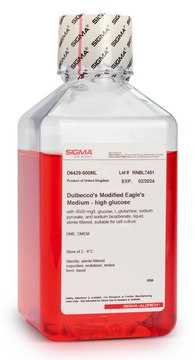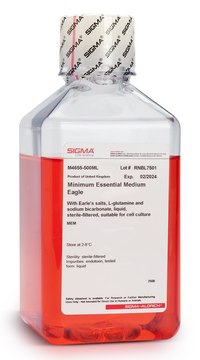D7777
Medio de Eagle modificado de Dulbecco, glucosa elevada
With 4500 mg/L glucose, L-glutamine, and sodium pyruvate, without sodium bicarbonate, powder, suitable for cell culture
Sinónimos:
DME, DMEM
Iniciar sesiónpara Ver la Fijación de precios por contrato y de la organización
About This Item
UNSPSC Code:
12352207
NACRES:
NA.75
Productos recomendados
Quality Level
form
powder
technique(s)
cell culture | mammalian: suitable
components
glucose: high
sodium pyruvate: yes
NaHCO3: no
HEPES: no
phenol red: yes
L-glutamine: yes
shipped in
ambient
storage temp.
2-8°C
¿Está buscando productos similares? Visita Guía de comparación de productos
Application
El medio de Eagle modificado de Dulbecco (DMEM) es una modificación del medio basal Eagle (BME) que contiene el cuádruple de concentraciones de aminoácidos y vitaminas. La formulación original contenía 1000 mg/l de glucosa y se utilizaba para cultivar células embrionarias de ratón. Desde entonces, se ha modificado de varias formas para soportar cultivos primarios de células de ratón y de pollo, así como una variedad de células normales y transformadas. Cada uno de estos medios ofrece una combinación diferente de L-glutamina y piruvato sódico. Además, los niveles de glucosa se han elevado a 4 500 mg/l, lo que contribuye al nombre «DMEM/High».
Quantity
Formulated to contain 13.5 grams of powder per liter of medium.
Reconstitution
Supplement with 3.7 g/L sodium bicarbonate
Related product
Referencia del producto
Descripción
Precios
also commonly purchased with this product
Referencia del producto
Descripción
Precios
supplement
Referencia del producto
Descripción
Precios
Storage Class
13 - Non Combustible Solids
wgk_germany
WGK 1
Elija entre una de las versiones más recientes:
¿Ya tiene este producto?
Encuentre la documentación para los productos que ha comprado recientemente en la Biblioteca de documentos.
Los clientes también vieron
Assaf Almog et al.
PLoS computational biology, 15(5), e1006934-e1006934 (2019-05-03)
Neural systems are organized in a modular way, serving multiple functionalities. This multiplicity requires that both positive (e.g. excitatory, phase-coherent) and negative (e.g. inhibitory, phase-opposing) interactions take place across brain modules. Unfortunately, most methods to detect modules from time series
Emilia Galli et al.
Cell transplantation, 28(4), 413-424 (2019-03-08)
Cerebral dopamine neurotrophic factor (CDNF) shows beneficial effects in rodent models of Parkinson's and Alzheimer's disease. The brain is a challenging target for protein therapy due to its exclusive blood-brain barrier. Hence, the therapeutic protein should be delivered directly to
Otávio Valério de Carvalho et al.
Virology journal, 14(1), 124-124 (2017-06-28)
Canine distemper (CD) is a widespread infectious disease that can severely impact a variety of species in the order Carnivora, as well as non-carnivore species such as non-human primates. Despite large-scale vaccination campaigns, several fatal outbreaks have been reported in
Jie Wang et al.
Molecular medicine reports, 22(2), 1111-1118 (2020-07-07)
Neuromyelitis optica (NMO) is a severe neurological demyelinating autoimmune disease that affects the optic nerves and spinal cord. There is currently no effective cure or therapy. Aquaporin‑4 (AQP4) is a known target of the autoimmune antibody NMO‑IgG. Therefore, binding of
Agnieszka Cześcik et al.
Polish journal of microbiology, 63(2), 203-209 (2014-08-15)
With the implementation of the WHO strategic plan for the elimination of measles, the number of measles cases in European Region has decreased. However, outbreaks are still observed. Although most measles cases affect unvaccinated individuals, cases with vaccinated persons are
Nuestro equipo de científicos tiene experiencia en todas las áreas de investigación: Ciencias de la vida, Ciencia de los materiales, Síntesis química, Cromatografía, Analítica y muchas otras.
Póngase en contacto con el Servicio técnico




